MARIANI’S
March
18, 2007
NEWSLETTER

New
Recipes for Good Eating (1953)
WEBSITE: To
go to my web site, in which I will update food
&
travel information and help link readers to other first-rate travel
& food sites, click on: home page
ARCHIVE: Readers may now access
an
Archive of all past newsletters--each annotated--dating back to July,
2003, by simply clicking on www.johnmariani.com/archive
SUBSCRIBE AND
UN-SUBSCRIBE: You may subscribe anyone you wish
to this newsletter--free of charge--by
clicking here.
In
This Issue
NEW YORK CORNER: Dennis Foy by John Mariani
NEW MICHELIN GUIDES FOR PARIS AND LONDON by John Mariani
NOTES FROM THE WINE CELLAR: Matt Kramer Makes Italian Wine Easy by John Mariani
QUICK BYTES
AROUND COGNAC
by John Mariani
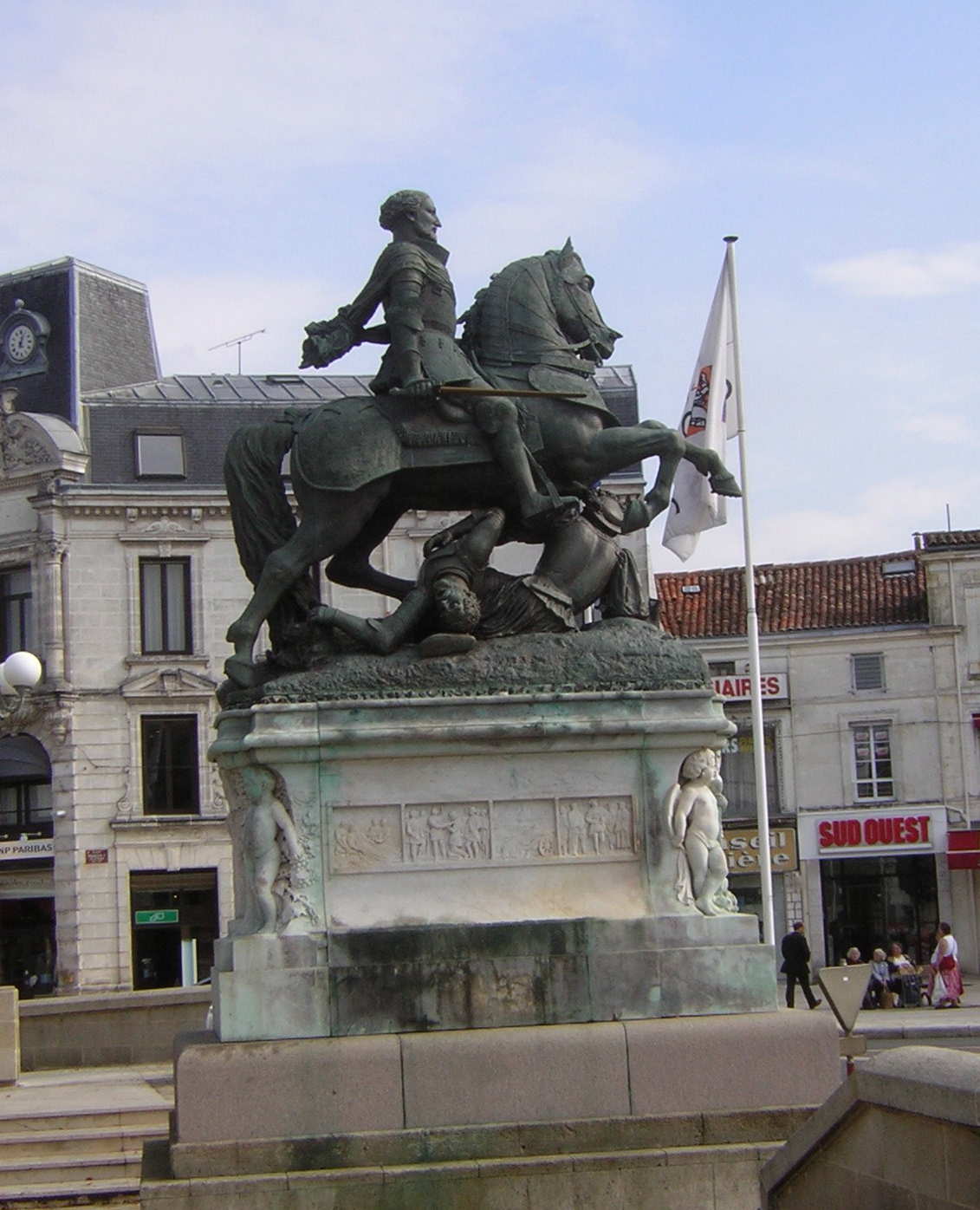 Cognac is either a
small city or a large town (its sister city is Deniston,
Texas), for it is easy enough to walk around it in an hour or two and
need not spend much more time there unless you are a wine
merchant. For the city that gives its name to one
of the world's greatest brandies is distilled and bottled and shipped,
with many of the ancient names--Otard, Hennessey, Courvoisier, and many
others--open to visit, which is well worth your while.
Cognac is either a
small city or a large town (its sister city is Deniston,
Texas), for it is easy enough to walk around it in an hour or two and
need not spend much more time there unless you are a wine
merchant. For the city that gives its name to one
of the world's greatest brandies is distilled and bottled and shipped,
with many of the ancient names--Otard, Hennessey, Courvoisier, and many
others--open to visit, which is well worth your while.Its location on the Charente River long made it ideal for shipping its products, and Cognac lies along one of Christendom's holy pilgrimage routes, Santiago de Campostella. The city's history is as quarrelsome as any in Charlemagne's realm, though Francis I (left), who reigned from 1515-1547, settled things down by encouraging Cognac to become a commercial center for wine and spirits, and his symbol, the salamander, is found carved and incorporated into scores of the buildings here, some dating back to the Renaissance.
The Château de Cognac was Francis I's birthplace, and it contains rooms designed by Leonardo da Vinci; it was taken over by Mayor Otard in 1795 and is now owned by the firm of Otard, which is itself now owned by Bacardi. The château is open to the public, and the tour includes visits throughout the huge structure, which includes including some hokey mannequins in period dress, and a stroll through the massive, endless cellars, whose walls are three meters thick. The State Hall (below, right) is magnificent and is immaculately kept so that it looks the same as the day Francis was born. The artifacts of ancient and modern distillation methods are also well explained and shown, too, and you'll inhbale some of the "angel's share"--to spirist that evaporate into the air and, apparently, to the heavens.
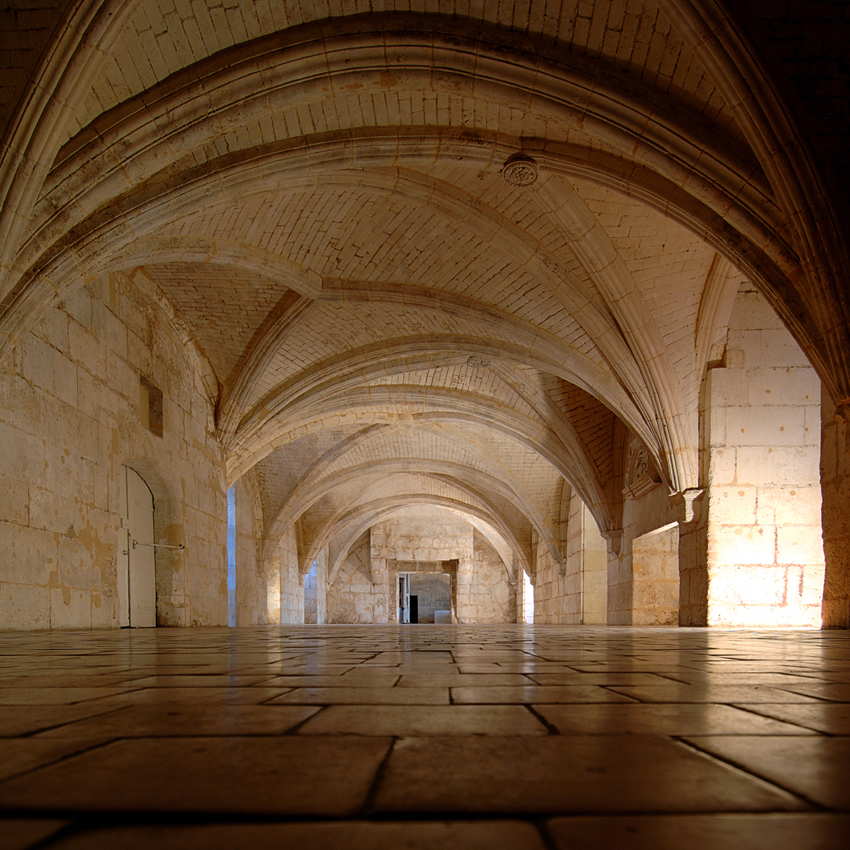
Other than that, you may soon be able to visit the headquarters of Grey Goose, the French vodka company also owned by Bacardi, just outside of town. It's quite an impressive, very modern place, with a tasting room and videos, and there are plans to open it to the public. I was there when they introcued their new Poire (pear), which is the only flavored vodka I've ever enjoyed.
Otherwise, stroll the old section of the city of Cognac, with its quaint central square with its equestrian statue of Francis I from which lead all the retail and market streets, and there is a delightful semi-indoor market worth visiting to see what the Cognacais are likely to be having for supper. There are some charming bistros and cafés along the way, and in the square there is the bustling Brasserie Le Coq D'Or (below; Place François 1er; 05-45-82-0256), set on two floors lined with banquettes and served by a brigade of fast-moving waitresses who carry out huge platters of choucroute, shellfish, and meats to ravenous customers who pack the place lunch and dinnertime. It has the usual art nouveau appointments, though it will win no design awards, and everything here is paced for a racing appetite.
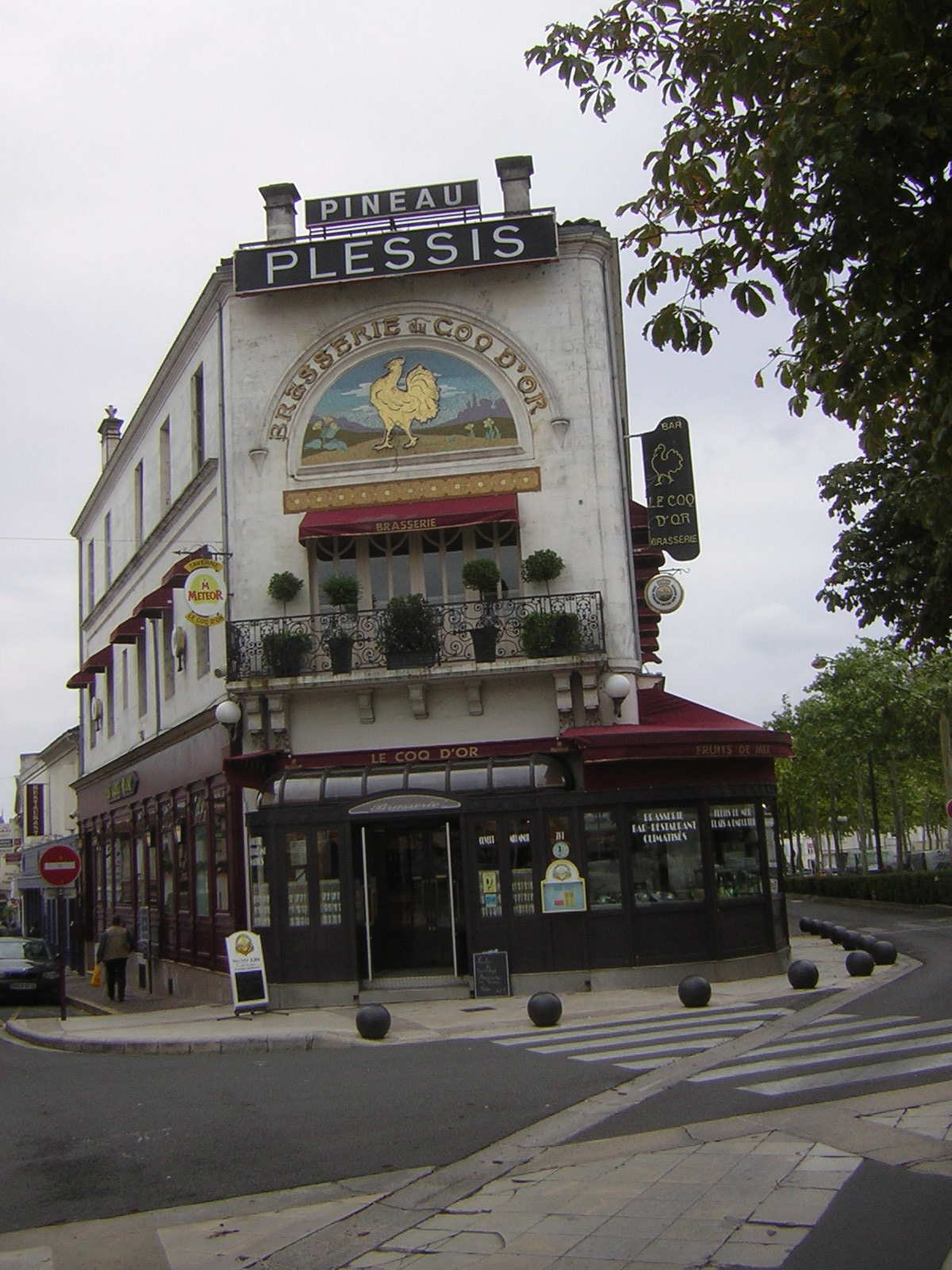 The choucroute
is indeed very good (if steamy) and
lavishly proportioned, with layers of sausages and jarret de porc over
steaming, winey sauerkraut. Mussels are cooked in Pineau des
Charentes wine, and the shellfish are superbly fresh. Cold
langoustines with a wonderfully rich mayonnaise made for a fine
starter, but soupe des poissons
was very bland, and the sole a la
meunière with
boring
white rice lacked flavor. The frites,
surprisingly, were terrible, limp and oily.
The choucroute
is indeed very good (if steamy) and
lavishly proportioned, with layers of sausages and jarret de porc over
steaming, winey sauerkraut. Mussels are cooked in Pineau des
Charentes wine, and the shellfish are superbly fresh. Cold
langoustines with a wonderfully rich mayonnaise made for a fine
starter, but soupe des poissons
was very bland, and the sole a la
meunière with
boring
white rice lacked flavor. The frites,
surprisingly, were terrible, limp and oily.Considerably higher on the hog is La Ribaudière (Place du Port; 05-45-81-3054), a very swank restaurant in Bourg-Charente with a clientele that tends to dress to the nines for the big night out, and it obviously draws a good deal of its business from the Cognac trade in the area. Chef-owner Thierry Verrat controls every aspect of the large restaurant, which has several dining rooms on two floors (below) and a lovely patio on the banks of the Charente river. He sources his products as locally as possible, and his cuisine is simple and based on those ingredients to provide the principal flavors.
I was with a large crowd of people and managed to steal bites from several plates, which included a millefeuille of sea spider with tomatoes laced with vinegar, and a similar treatment of langoustines and dried tomatoes with fennel. Local farms' eggs were stuffed with parsley, salmon, and tomato--a lovely idea--and a Saint Pierre cheese in perfect condition was perfumed with roast laurel, fava beans, Iberian ham, accompanied by a little morsel of aged goat's cheese.
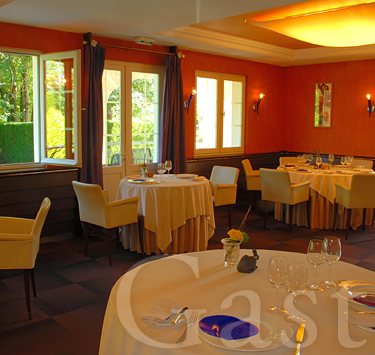
A simply cooked filet of sole had a generous portion of black truffles along with homey polenta, itself lavished with diced truffles. Boring indeed was a côte de boeuf grilled with gray sea salt, served with marrow and cèpes, while breast of chicken cooked in a cocotte with a side dish of ravioli stuffed with fromage blanc was very good. Best of the main courses was a roasted squab with an étouffée of morels. Cheese followed from a well-arranged cart, then a soufflé flavored with lemon vodka, and another chocolate dessert of various sweets--a crispy chocolate croustillant, with chocolate cream, ice cream, and hot chocolate.
The winelist is superb, as befits a restaurant of this caliber. There are several pricing options for dinner, including a very reasonable 4-course menu of the season at just 35 euros (service and tax included), a "menu gourmand" at 45-50 euros, a lobster menu "of discovery" at 70 euros, and à la carte, with first courses 24-35 euros and main courses 26-32 euros.
Much in a similar vein of luxury is the Château de l'Yeuse (65 rue de Bellevue ; 05 45 36 82 60; below), with a very formal dining room and a beautiful terrace. Here Chef Pascal Nebout does classic French cuisine, not with a great deal of flair but with considerable conservative taste in dishes like pastry-crusted scallops with cauliflower,
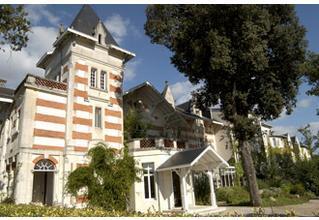 very finely grained roast veal with girolles mushrooms,
and a fine assiette of
cheeses. It's a prettier place than it is distinctive in its cuisine.
very finely grained roast veal with girolles mushrooms,
and a fine assiette of
cheeses. It's a prettier place than it is distinctive in its cuisine.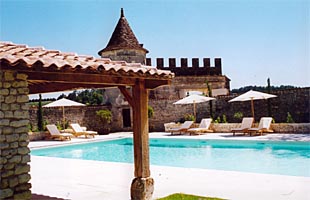
We were staying at a charming, very beautiful small chateau called Logis du Fresne (right) in Juillac Le Coq, smack in the middle of the farm and vineyard country that rolls around it. The rooms have both a rusticity and country elegance that is replicated in the outdoor patio and the lovely people who run it with a very warm heart. It is also located in a serenely quiet region of farmland and vineyards, and if there are no mosquitos, letting the air of the night in
has as soprofic effect as does the glass on Cognac on your bed table.
NEW YORK CORNER
by John Mariani
DENNIS FOY
212-625-1007
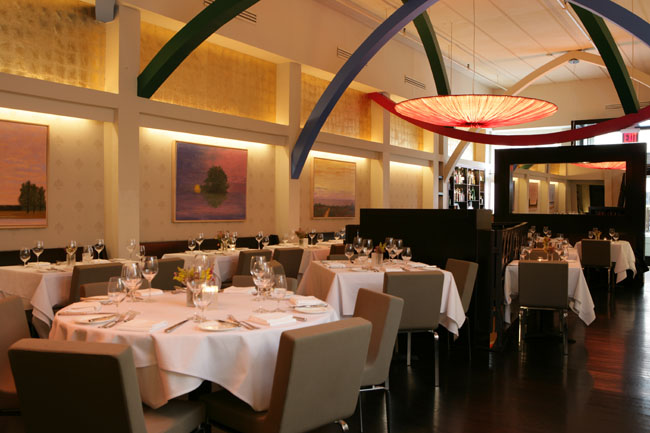
The premises that were previously La Scolca, retain the dramatic arching beams of the ceiling, though now they are painted green, red, and blue and look rather like a floating Frank Stella painting. The rest of the artwork (for sale), set against gold-leaf walls, is by Foy himself, who has spent as much time at that craft as he has in cooking, and both talents show similarly on the plate, with strong colors and simple shapes.
Is this really the first new dining room I've visited in months to have real tablecloths? How refreshing, clean, bright, and soft! Pretty flowers deck the tables. Stemware is thin, silverware of fine quality, and the overhead silk-fabric lighting--glowing like onion skin--is perfect, convivial, and flattering, as is the civilized sound level. It's even the ideal size for a personalized, chef-run restaurant, 60 seats. (Upstairs is a 30-seat private dining room.)
There is a judicious 100-label winelist here with plenty to choose from under $50, and actually not too many high-priced bottles, though they stand out like sore thumbs among other less expensive wines on the list.

I always like a menu that is not too complex, easy to read, and with just enough choice and imagination to make that choice difficult. Our table of four wanted to devour everything on it--seven appetizers, nine entrees--but held ourselves to the standard starter and main course. There was an amuse of thick, very dark, very rich and delicious lentil soup, then we began with a silky terrine of French goose foie gras in an eiswein jelly with a purée of prunes and a little shower of white flakes on top that Foy makes by mixing foie gras fat with tapioca powder--a great idea sure to be copied. The dish is described as "Eis and Snow," and that it is (right).
A warm crabmeat terrine was so simple, so good, just kissed with fresh thyme, while big-eye tuna tartare with apple and cinnamon was, if not inspired, a fine rendering of a ubiquitous dish. If I recall, Foy has been serving sautéed potato gnocchi for a while now, and well he should: the current dish, with sage and and chives and some tiny mushrooms epitomizes the directness Italian pasta should always have.
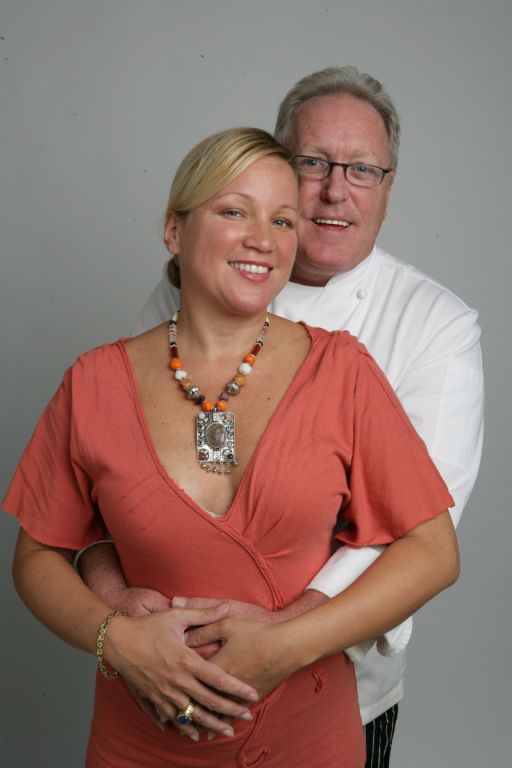 For entrees there was very tender pink
squab, fat and buxom indeed, with green vegetables, saline-bitter
spinach,
the sweetness of spiced golden raisins, and argan oil (I still haven't
a clue what that is). Braised pork from the Berkshires had plenty of
flavor and a judicious amount of fat, served with a lovely quince tart,
sow peas, honey, cumin, and saffron--each spice very subtly adding
another spark of savoriness. Arctic char was white and meaty, with
spinach, a dusting of nutmeg and pommes
salardaise, sautéed in
goose fat with garlic and cèpes. A dish of fluke, squid,
white beans, fennel, chorizo, and almonds was rather flaccid and bland.
For entrees there was very tender pink
squab, fat and buxom indeed, with green vegetables, saline-bitter
spinach,
the sweetness of spiced golden raisins, and argan oil (I still haven't
a clue what that is). Braised pork from the Berkshires had plenty of
flavor and a judicious amount of fat, served with a lovely quince tart,
sow peas, honey, cumin, and saffron--each spice very subtly adding
another spark of savoriness. Arctic char was white and meaty, with
spinach, a dusting of nutmeg and pommes
salardaise, sautéed in
goose fat with garlic and cèpes. A dish of fluke, squid,
white beans, fennel, chorizo, and almonds was rather flaccid and bland."Refined" is the word I would repeat again and again if I repeated myself, but I will save it for the desserts--rather gently priced at $10--like the black plum financier with winter fruit compote and rum ice cream; the coconut caramel bar with mango lime sorbet and a ribbon litchi fruit; a pear and pistachio tart with brandied cherries and vanilla ice cream; and a rich chocolate and hazelnut-studded dome with coffee brûlée and dulce de leche--a devastatingly good ending for a, yes, highly refined evening.
But that's what struck me most about this graciously civilized night out in New York, without the noise, the puerile service, the slovenly clientele, and the throbbing music you now find all over town. The cooking is all that cooking should be and rarely is, clean, focused, and very good. I'm glad to have the Foys back in NYC.
NEW MICHELIN GUIDES FOR PARIS AND LONDON
by John Mariani
 Following the format of Michelin's U.S. guides to New York City and San
Francisco and the Bay Area, the ratings company has issued new
Paris and London guides (separate from the more comprehensive France
and Great Britain and Ireland guides, also issued recently). This
is all to the good for now every restaurant and hotel gets a write-up
(in the past Michelin wrote not a word about their selections until
adding a line or two in 2000), and the restaurants awarded one to three
stars get a full page with photos. There are all the usual
icons--an umbrella and table for outside dining, a bunch of grapes for
a "particularly interesting wine list," a figure at a lectern for a
conference room, and the head of the cartoon character Bibendum (below) licking
his lips to indicate a "Bib Gourmand" restaurant with "good cooking at
moderate prices."
Following the format of Michelin's U.S. guides to New York City and San
Francisco and the Bay Area, the ratings company has issued new
Paris and London guides (separate from the more comprehensive France
and Great Britain and Ireland guides, also issued recently). This
is all to the good for now every restaurant and hotel gets a write-up
(in the past Michelin wrote not a word about their selections until
adding a line or two in 2000), and the restaurants awarded one to three
stars get a full page with photos. There are all the usual
icons--an umbrella and table for outside dining, a bunch of grapes for
a "particularly interesting wine list," a figure at a lectern for a
conference room, and the head of the cartoon character Bibendum (below) licking
his lips to indicate a "Bib Gourmand" restaurant with "good cooking at
moderate prices."This last icon might well be the most valuable virtue of the new Michelin guides, for they make clear that one does not have to spend a fortune to eat well in Paris or London. There are scores of Paris restaurants with a menu at 33 euros ($43), and scores more at 35 euros ($46). Alas, the price of dining at the star level is daunting in both cities, though more so in Paris than in London: The lowest price for a three-course meal (à la carte) at the one-star Gérard Besson is 100 euros ($131); two-star Lasserre runs 122 euros ($160), and three-star Pierre Gagnaire will cost a minimum of 231 euros ($303); these include tax and service but not wine. In London, the one-star Amaya has a minimum of 30 pounds ($58), as does the the two-star Square, and London's only three-star restaurant, Gordon Ramsay, starts at 40 pounds ($77); depending on the restaurant a 12-15% service charge may be added on to the bill, which makes dining in London quite comparable, if not a bit lower, to doing so at similar restaurants in NYC, Los Angeles, and Las Vegas.
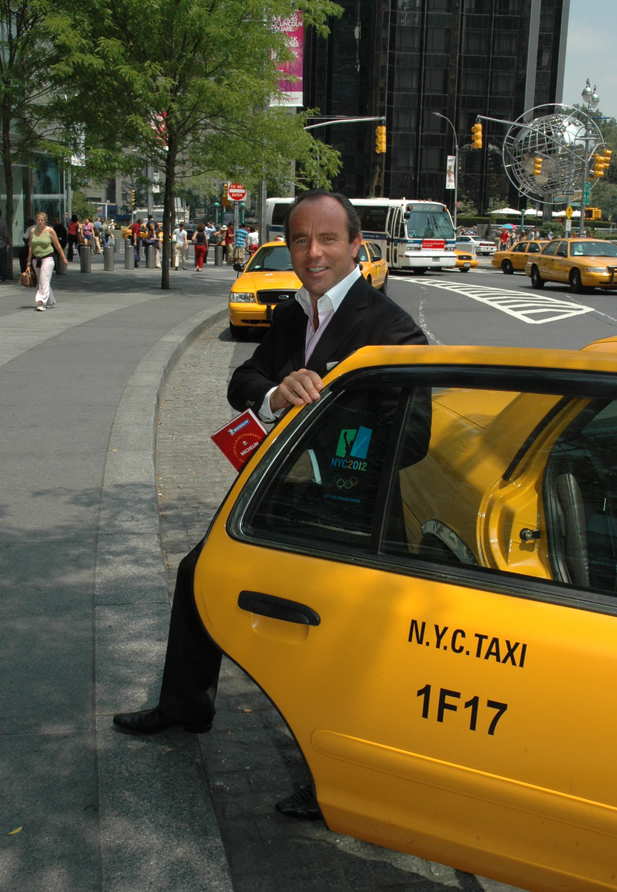
One can't help but feel, then, that the price of a star is getting more and more exorbitant, and just looking at the festooned dining rooms that have stars makes one wonder if food and food alone determines the star rating, as Michelin has always contended. Indeed, in awarding one star to the modest-looking Assaggi in London, the guide reads, "Those in any doubt about the fact that Michelin stars are awarded for the quality of the food on the plate and not for the style or decoration of a place should come to Assaggi." But Assaggi is such a rare exception among the stars that the guide's contention falls rather flat. In Paris the kinds of restaurants that annually receive stars are the kind of restaurants with 50 seats, extravagant decor that extends to the restrooms, a kitchen brigade of 25 and a service staff of equal number. Some may be more stark than others, but the Starck in question is probably Philippe, and many might argue that the guide is still very, very generous to Paris restaurants long resting on their Michelin laurels, like La Tour d'Argent and Hélène Darroze.
In an interview I had with the dynamic director of the guides, Jean-Luc Naret (right), who can be credited with the improvements of the past two years, he admitted that the stars are not yet as highly regarded in the U.S. as in Europe. The reception of the local media to the New York guide was actually quite warm, though San Francisco foodies threw fits over the choices and ratings for their region. "The problem is that the rankings in the U.S. tend to be four or five stars," said Naret, "so people see us give a restaurant one star and they don't think that is very high, although Alice Waters called and said she was so pleased she got one star. A Michelin star means yours is one of the 1,000 best restaurants in the entire world, while three stars means you are one of the 60 best."
One of the criticisms of the guides, which I share, is that to read through the text on any of the restaurants, you would think none has a single flaw, no notice of weak desserts, uncomfortable seating, loud music, poor service. "It's true," said Naret. "We were very mellow in the beginning. We felt, let’s be positive, let’s not be negative. But we have heard this comment and the next ones will be very different."
 So what do the new Paris and
London guides show?
So what do the new Paris and
London guides show?
by John Mariani
Everything You Need to Know About Italian Wine Is in Matt Kramer's New Book
Except for an encyclopedia, I can’t think of any reason why a book about wine should run more than 280 pages, which happens to be the length of Matt Kramer’s Making Sense of Italian Wine (Running Press, $24.95).
As Kramer writes in his Preface, “Italian wine, like quantum physics, is such a vast subject that even the most assured, experienced tasters are left scratching their heads over some new madness. No nation so relentlessly, even profligately, issues so many wines. No winegrowers anywhere are so willing—insistent even—on throwing over the older order as Italians. Yet no sooner do they do so than a revisionist reaction sets in. It’s as close to a permanent wine revolution as can be imagined.”
Kramer certainly has as much experience in such matters as any living wine writer: He is a longtime wine columnist for Wine Spectator, Diversion, and The Oregonian, and has traveled extensively in
Kramer knows that covering such a huge, chameleon subject as Italian wine makes commentary on bottlings of the moment as out-of-date as last season’s hemlines. Instead, he focuses on ten aspects of a wine: The type or name (which may be either by grape or place); region; grapes; “The Tradition,” by which he provides the historic, cultural foundation for wines that allows the reader to understand what “the modernists are opposing or seeking to modify”; How the wines have changed over centuries; noteworthy producers, both traditionalists and modernists; What do the Locals Eat with this Wine?; Whose wine would Kramer buy at a wineshop (he favors low-yield vineyards); wines “Worth Searching For,” including the sub-category “Don’t die without trying it”; and Similar Wines from the Same Neighborhood.
He then, very sensibly, spends 3-8 pages on wines alphabetically, from Aglianico del Vulture from
In two paragraphs on Aglianico he tells you when the vines first arrived in
Of Veneto’s Bardolino, he is refreshingly candid, contending that declining sales in the 1980s caused local producers not to make better Bardolino but to imitate Beaujolais Nouveau: “I’d like to say that, embarrassed by the error of their ways, Bardolino’s producers are grasping their way back to greatness. They aren’t.”
Kramer (below) is right on the mark when he characterizes the scores of new Brunello di Montalcino produces as problematic. “Never before have we seen so many Brunellos,” he writes, “Yet the quality is distressingly variable. Simply put, many . . . aren’t worth the invariably high price being asked.” He then alerts you to which producers’ wines—both traditionalists and modernists—really are.
And so it goes for 280 user-friendly pages, which include a very helpful section on “Frequently Seen Wine Label Words” like abbazia (abbey), colle (hill), podere (farm), prato (field), vecchio (old), and vinicola (winery).
To order a copy of this book from amazon.com click on the book cover above.
John Mariani's weekly wine column appears in Bloomberg Muse News, from which this story was adapted. Bloomberg News covers Culture from art, books, and theater to wine, travel, and food on a daily basis, and some of its articles play of the Saturday Bloomberg Radio and TV.
Everett Potter's Travel Report:
QUICK BYTES
* From March 19-24, Taberna del Alabardero celebrates 18 years in Washington DC with a week of festivities by offering a 3-course menu of special dishes from Spain, and a “Flamenco Extravaganza,” with dancers Carmela Greco and Edwin Aparicio, guitarist Richard Marlow, and singer Alfonso Cid; a special 18th Anniversary Wine Dinner prepared by guest chefs Miguel Angel Prieto and José Molina of Taberna del Alabardero in Sevilla, Spain, and Executive Chef Santi Zabaleta. $55 pp. To cap off the week-long celebration, Taberna del Alabardero has teamed up with Aurelio Cabestrero to present an 18th Anniversary 7-course Wine Dinner on March 24, paired with wines selected by Sommelier David Bueno. $130 pp. Call 202-429-2200; visit www.alabardero.com.
* On March 31, at Nana in
* Alexander's Steakhouse in
~~~~~~~~~~~~~~~~~~~~~~~~~~~~~~~~~~~~~~~~~~~~~~~~~~~~~~~~~~~~~~~~~~~~~~~~~
MARIANI'S VIRTUAL GOURMET NEWSLETTER is published weekly. Editor/Publisher:
John Mariani. Contributing Writers: Robert Mariani, Naomi
Kooker, Kirsten Skogerson, Edward Brivio, Mort
Hochstein, Suzanne Wright. Contributing
Photographers: Galina Stepanoff-Dargery, Bobby Pirillo. Technical
Advisor: Gerry McLoughlin.
Any of John Mariani's books below
may be ordered from amazon.com by clicking on the cover image.
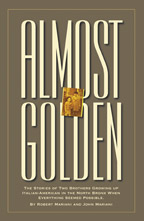 My
newest book, written with my brother Robert Mariani, is a memoir of our
years growing up in the My
newest book, written with my brother Robert Mariani, is a memoir of our
years growing up in the For those of you who don't think of the Robert and I think you'll enjoy this very personal look at our --John Mariani |
 |
 |
 |
 |
 |
 |
copyright John Mariani 2007

